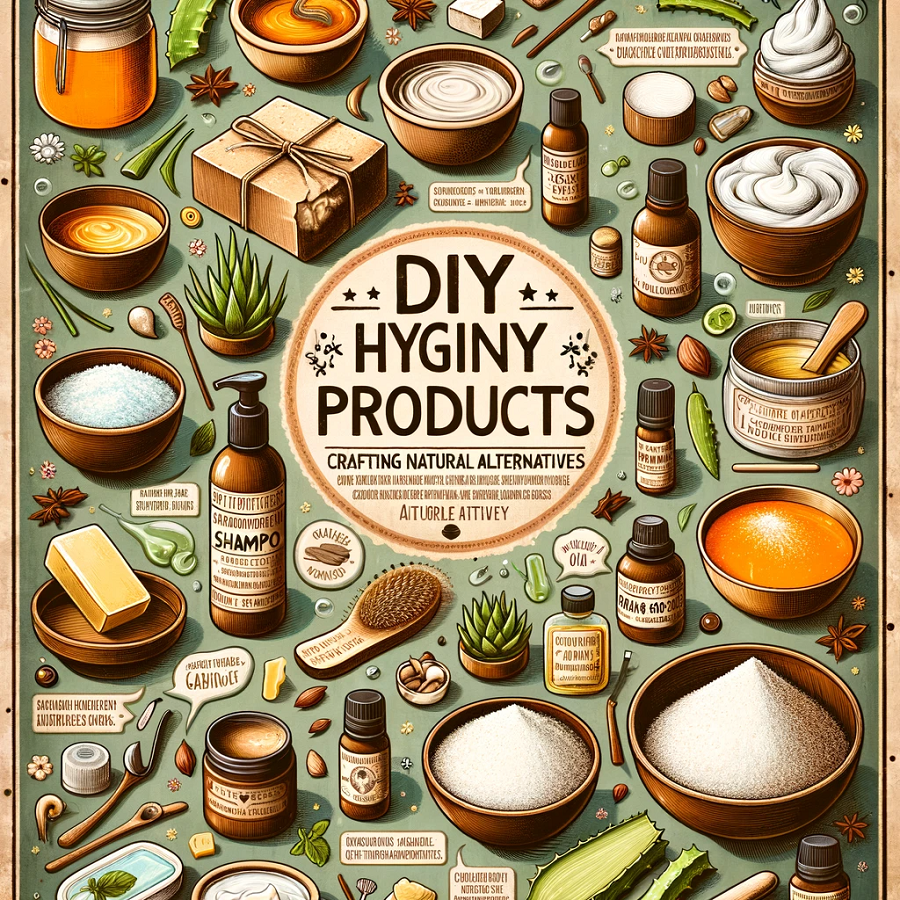In an age where health-conscious living and sustainability take center stage, the DIY hygiene product revolution has emerged as a beacon of change. The shift towards natural and homemade solutions has captured the hearts of individuals seeking alternatives to commercial products laden with chemicals and preservatives. In this comprehensive guide, we’ll explore the art of crafting your own hygiene products right in the comfort of your home. From the fundamentals of DIY product making to the wonders of natural ingredients and the meticulous science of measurements, we’ll equip you with the knowledge and skills to embark on your homemade hygiene journey. Join us as we delve into the world of DIY hygiene products, discovering the joy of self-sufficiency, customization, and embracing nature’s bountiful offerings for healthier, more sustainable personal care. Welcome to the realm of DIY Hygiene Products – where nature meets craftsmanship!
| Tip | Description |
|---|---|
| Use clean utensils and containers | Maintain a hygienic workspace by cleaning all tools and containers before starting your DIY project. |
| Patch test new ingredients | Before applying a DIY product to your skin, do a patch test to check for any allergic reactions or sensitivities. |
| Invest in quality ingredients | Opt for high-quality, natural ingredients to ensure the effectiveness and safety of your DIY hygiene products. |
| Follow recipes carefully | Precise measurements and steps are crucial; don’t improvise unless you’re experienced in formulating skincare. |
| Label and date your creations | Properly label your products with ingredients and dates to track their shelf life and avoid confusion. |
| Store products in a cool, dark place | To extend shelf life, keep your DIY products away from direct sunlight and extreme temperatures. |
| Use distilled water for formulations | When water is needed in your recipe, use distilled water to prevent bacterial contamination. |
| Include a natural preservative | If your DIY product contains water or water-based ingredients, consider adding a natural preservative to extend shelf life. |
| Be cautious with essential oils | Essential oils are potent; use them sparingly and research their safe dilution levels for different applications. |
| Research ingredient compatibility | Some ingredients may not mix well or can cause instability; research compatibility before combining them. |
| Customize for your skin type | Tailor your DIY products to your specific skin type and concerns, adjusting ingredients accordingly. |
| Keep safety in mind | Follow safety guidelines and wear appropriate protective gear (e.g., gloves) when working with certain ingredients. |
| Monitor product changes over time | Pay attention to changes in texture, scent, or color; this may indicate that your product is no longer safe to use. |
1. Introduction to DIY Hygiene Products: Embracing Natural Solutions
Why Choose DIY Hygiene Products?
- The shift towards natural and homemade solutions.
- Reducing exposure to harmful chemicals in commercial products.
The DIY Hygiene Revolution
- Growing popularity of homemade hygiene products.
- Environmental and health-conscious consumers driving the trend.
2. The Basics of Crafting Your Own Hygiene Products at Home
Essential Tools and Equipment
- A list of basic items you’ll need for DIY hygiene products.
- Explanation of their uses in the crafting process.
Common Ingredients in DIY Hygiene Products
- Overview of key ingredients like oils, butters, and essential oils.
- Their benefits and how they contribute to product effectiveness.
3. Natural Ingredients for Effective DIY Hygiene Solutions
Choosing the Right Ingredients
- How to select ingredients based on skin type and desired product.
- Considerations for allergies and sensitivities.
Key Natural Ingredients and Their Benefits
- In-depth look at popular ingredients like coconut oil, shea butter, and aloe vera.
- How these ingredients improve skin and hair health.
4. Step-by-Step Guide: Creating Your First DIY Hygiene Product
Getting Started: Preparing for Your DIY Project
- Preparing your workspace and gathering ingredients.
- The importance of cleanliness and hygiene in the process.
Creating a DIY Hygiene Product: A Basic Recipe
- A simple recipe for a natural homemade product (e.g., homemade body scrub).
- Detailed step-by-step instructions for crafting the product.
Tips for Success
- Common mistakes to avoid in DIY hygiene product making.
- Troubleshooting and solutions for potential issues.
5. Calculations and Measurements: Getting Your DIY Mixtures Right
Importance of Precision
- Why accurate measurements are crucial in DIY hygiene product making.
- Ensuring product consistency and effectiveness.
Measuring Ingredients
- Different units of measurement (e.g., grams, milliliters, teaspoons) and when to use them.
- Using digital scales and measuring cups for precision.
Calculating Ratios
- Understanding the ratio of ingredients for different products.
- How to adjust ratios for variations in product thickness or scent.
6. Customizing Your DIY Hygiene Products for Specific Needs
Tailoring Products to Your Preferences
- Adding scents with essential oils for a personalized touch.
- Adjusting ingredients for dry, oily, or sensitive skin types.
Targeted DIY Solutions
- Recipes for specific needs, such as acne-fighting face wash or dandruff control shampoo.
- Addressing common skin and hair concerns naturally.
7. The Benefits of Switching to Natural, Homemade Hygiene Products
Gentle on Your Skin
- How natural ingredients are less likely to cause irritation or allergies.
- The soothing and nourishing effects of DIY products.
Eco-Friendly and Sustainable
- Reducing plastic waste by using reusable containers.
- Lowering your carbon footprint by avoiding harmful chemicals.
Cost-Effective DIY Solutions
- Comparing the costs of DIY products to commercial alternatives.
- Saving money in the long run with bulk ingredient purchases.
8. Safety and Preservation Tips for DIY Hygiene Products
Understanding Shelf Life
- The importance of knowing how long your homemade products last.
- Tips for labeling and tracking expiration dates.
Natural Preservatives
- Options for natural preservatives like vitamin E oil or rosemary extract.
- Ensuring your products stay safe to use over time.
Storage and Hygiene Practices
- Properly storing your DIY products to maintain quality.
- How to keep your workspace clean and hygienic.
Final Thoughts:
As we draw the curtains on this journey through the world of DIY hygiene products, it’s evident that the art of crafting natural alternatives holds immense promise. From the basics of ingredients and measurements to the customized solutions for specific needs, we’ve explored the vast landscape of homemade personal care.
The benefits are abundant – not only are these products gentle on your skin and eco-friendly, but they also empower you to take charge of your well-being. By embracing sustainability and self-sufficiency, you contribute to a healthier planet and a healthier you.
In the end, it’s not just about creating your own lotions, soaps, and shampoos; it’s about making a choice for a more sustainable and fulfilling lifestyle. So, embark on your DIY hygiene journey, experiment with natural ingredients, and craft a healthier and sustainable future for yourself and the world.
FAQs:
1. What are DIY hygiene products?
- DIY hygiene products are personal care items like lotions, soaps, shampoos, and deodorants that you can make at home using natural ingredients, rather than buying commercial products.
2. Why should I consider making my own hygiene products?
- Making your own hygiene products allows you to control the ingredients, avoid harmful chemicals, reduce waste, and customize products to your specific needs.
3. Are DIY hygiene products safe to use?
- Yes, when made following proper guidelines and using safe ingredients, DIY hygiene products are generally safe. It’s essential to research and follow recipes carefully.
4. What are some common ingredients in DIY hygiene products?
- Common ingredients include natural oils (like coconut and olive oil), shea butter, essential oils (for scent), aloe vera, and natural preservatives like vitamin E oil.
5. Can I customize DIY hygiene products for my skin type or preferences?
- Absolutely! DIY products can be tailored to suit your skin type, scent preferences, and specific needs. You can adjust ingredients accordingly.
6. Do I need special equipment to make DIY hygiene products?
- While you don’t need a fully-equipped laboratory, having basic tools like measuring cups, spoons, a digital scale, and mixing bowls can be helpful.
7. How long do DIY hygiene products last?
- The shelf life varies depending on the ingredients used and the presence of natural preservatives. Typically, most DIY products last several months to a year.
8. Are DIY hygiene products cost-effective compared to commercial ones?
- Yes, in the long run, DIY products can be cost-effective because you can buy ingredients in bulk and make multiple batches.
9. Are DIY hygiene products environmentally friendly?
- Yes, they are more eco-friendly as they reduce the need for single-use plastic packaging and minimize the environmental impact of manufacturing and transportation.
10. Where can I find reliable DIY hygiene product recipes?
- You can find recipes in books, online blogs, and video tutorials. Make sure to choose sources with a good reputation for accuracy and safety.




